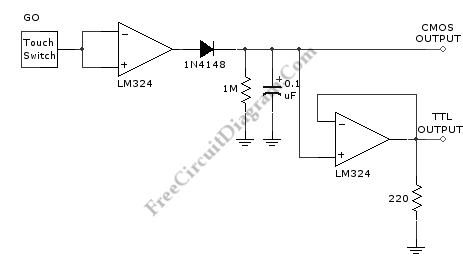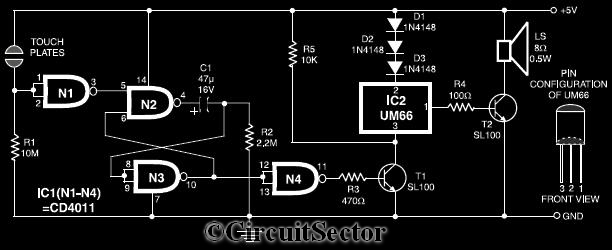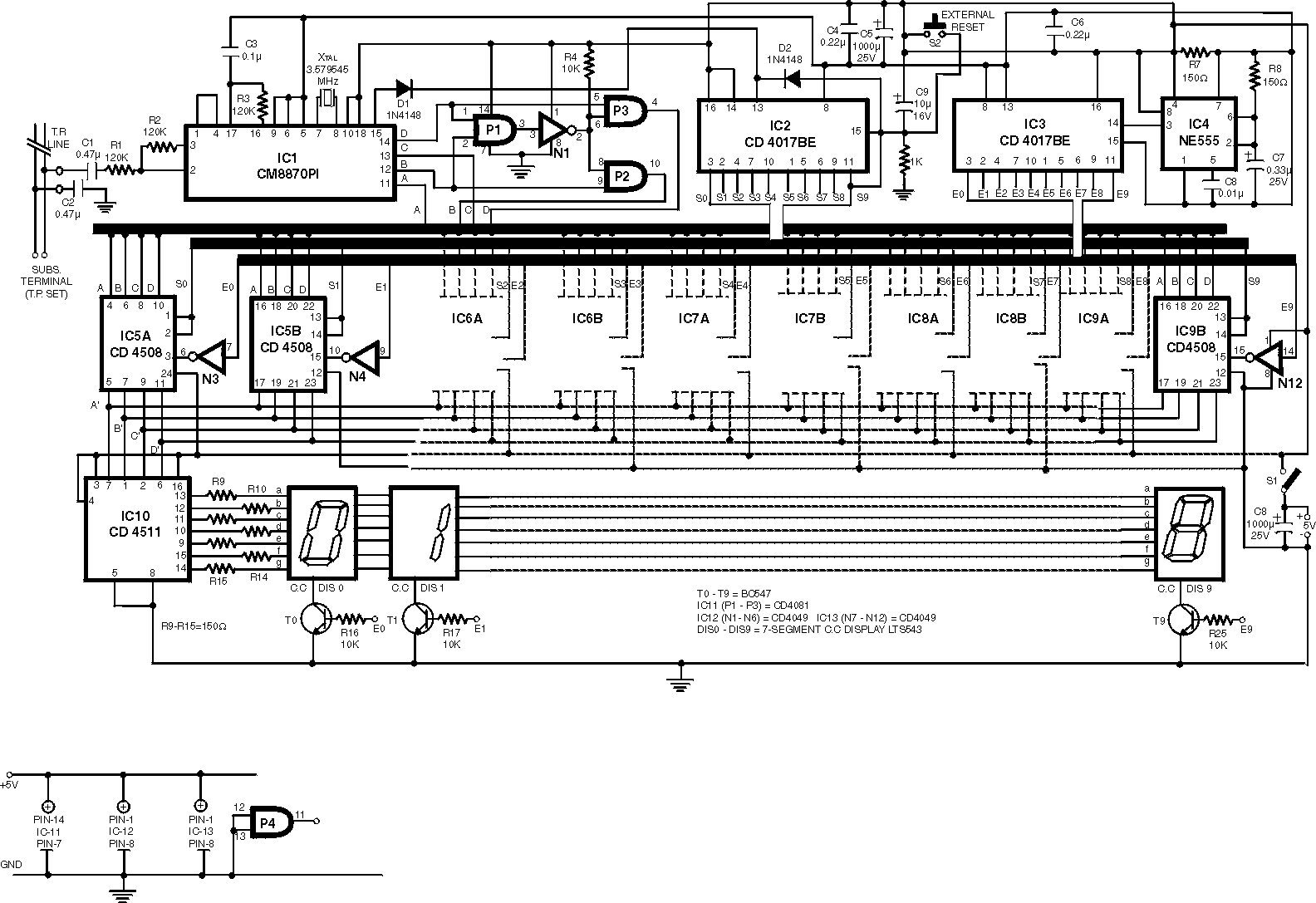
Morse Code with touch button (555)

This simple CPO is for those who want to practice Morse Code in a different way, ie without the morse key. It can be also used as a touch operated door bell. The popular timer IC555 is wired as an astable multivibrator. The frequency (tone) can be changed by varying the 100 K variable resistor between pin 7 and 6 of timer IC555. The volume can be changed by varying the 10 K variable resistor and the sensitivity of the touch plate can be controlled by adjusting the 1 K Ohms preset at pin 4 of IC555. The touch plate is connected to the base of transistor BC147B. Many touch switches restrict the size of the touch switch. In this circuit, the length of wire between the base of the transistor and the touch plate is not critical. In the prototype, 9 cm wire and a 3 x 6 cm 3mm thick aluminum plate were used for the touch plate.
The circuit described utilizes a 555 timer IC configured in an astable multivibrator mode, which produces a continuous square wave output. This output can be adjusted to generate different frequencies, allowing for varied Morse Code tones. The frequency is controlled by a 100 KΩ variable resistor connected between pins 7 (discharge) and 6 (threshold) of the 555 timer. When this resistor is adjusted, it changes the charge and discharge times of the timing capacitor, thus varying the output frequency.
The volume of the output sound can be controlled by another variable resistor, rated at 10 KΩ, which is likely connected to the output stage of the circuit. This resistor adjusts the amplitude of the signal sent to the speaker or buzzer, providing the user with the ability to set the desired loudness.
The sensitivity of the touch plate, which serves as the input for the circuit, is managed by a 1 KΩ preset resistor connected to pin 4 (reset) of the 555 timer. This configuration allows for the adjustment of how easily the touch plate responds to input, enabling customization based on user preference or environmental conditions.
The touch plate itself is connected to the base of a BC147B transistor, which functions as a switch or amplifier in the circuit. This configuration allows the low current from the touch plate to control a higher current output, facilitating the operation of a speaker or buzzer. Notably, the design of this circuit allows for flexibility in the placement of the touch plate, as the length of wire connecting the touch plate to the transistor is not critical, making it adaptable for various applications.
In the prototype, a 3 x 6 cm aluminum plate was utilized as the touch plate, with a wire length of 9 cm. The choice of aluminum is advantageous due to its conductive properties, ensuring reliable operation of the touch switch. This circuit can also serve as an innovative doorbell system, providing both functionality and a unique method for practicing Morse Code.This simple CPO is for those who want to practice Morse Code in a different way, ie with out the morse key. It can be also used as a touch operated door bell. The popular timer IC555 is wired as astable multivibrator. The frequency (tone) can be changed by varying the 100 K variable resistor between pin 7 and 6 of timer IC555.
The volume can be changed by varying the 10 K variable resistor and the sensitivity of touch plate can be controlled by adjusting the 1 K Ohms preset at pin 4 of IC555. The touch plate is connected to the base of transistor BC147B. Many touch switches restrict the size of the touch switch. In this circuit the length of wire between the base of the transistor and the touch plate is not critical. In prototype i used 9 cm wire and 3 x 6 cm 3mm thick aluminium plate for touch plate. 🔗 External reference
The circuit described utilizes a 555 timer IC configured in an astable multivibrator mode, which produces a continuous square wave output. This output can be adjusted to generate different frequencies, allowing for varied Morse Code tones. The frequency is controlled by a 100 KΩ variable resistor connected between pins 7 (discharge) and 6 (threshold) of the 555 timer. When this resistor is adjusted, it changes the charge and discharge times of the timing capacitor, thus varying the output frequency.
The volume of the output sound can be controlled by another variable resistor, rated at 10 KΩ, which is likely connected to the output stage of the circuit. This resistor adjusts the amplitude of the signal sent to the speaker or buzzer, providing the user with the ability to set the desired loudness.
The sensitivity of the touch plate, which serves as the input for the circuit, is managed by a 1 KΩ preset resistor connected to pin 4 (reset) of the 555 timer. This configuration allows for the adjustment of how easily the touch plate responds to input, enabling customization based on user preference or environmental conditions.
The touch plate itself is connected to the base of a BC147B transistor, which functions as a switch or amplifier in the circuit. This configuration allows the low current from the touch plate to control a higher current output, facilitating the operation of a speaker or buzzer. Notably, the design of this circuit allows for flexibility in the placement of the touch plate, as the length of wire connecting the touch plate to the transistor is not critical, making it adaptable for various applications.
In the prototype, a 3 x 6 cm aluminum plate was utilized as the touch plate, with a wire length of 9 cm. The choice of aluminum is advantageous due to its conductive properties, ensuring reliable operation of the touch switch. This circuit can also serve as an innovative doorbell system, providing both functionality and a unique method for practicing Morse Code.This simple CPO is for those who want to practice Morse Code in a different way, ie with out the morse key. It can be also used as a touch operated door bell. The popular timer IC555 is wired as astable multivibrator. The frequency (tone) can be changed by varying the 100 K variable resistor between pin 7 and 6 of timer IC555.
The volume can be changed by varying the 10 K variable resistor and the sensitivity of touch plate can be controlled by adjusting the 1 K Ohms preset at pin 4 of IC555. The touch plate is connected to the base of transistor BC147B. Many touch switches restrict the size of the touch switch. In this circuit the length of wire between the base of the transistor and the touch plate is not critical. In prototype i used 9 cm wire and 3 x 6 cm 3mm thick aluminium plate for touch plate. 🔗 External reference





